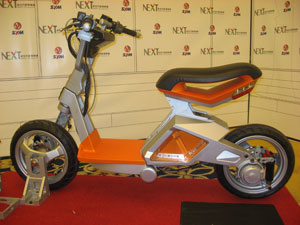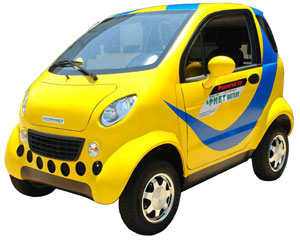Taiwan Poised to Develop Greener, Smarter LEVs
2009/04/24 | By Quincy LiangDue to limited driving range, light electric vehicles (LEVs) are making the biggest inroads today among commuters in high-density urban markets. Much of Taiwan's population is concentrated in the type of large and compact cities in which LEVs excel, giving the island a natural home market to fuel the sector's rise. A sound LEV manufacturing infrastructure and stringent emission standards promise to further electrify the local LEV industry.
Tapping this potential was a focal topic at a clean-energy vehicle forum held recently in Taipei. One of the speakers was James Wang, director of the intelligent mobility division of Mechanical & System Research Laboratories (MSL) under the Industrial Technology Research Institute (ITRI), co-chairman of the Advanced Vehicle Control & Safety system Committee under the Taiwan Intelligent Transportation System Association (ITS), and committee member of Automotive Electronics Committee of Taiwan Transportation Vehicle Manufacturers' Association (TTVMA)


Wang pointed out that LEVs will have a growing presence in the global vehicle industry as the world tackles global warming and energy shortages. LEVs address both problems by providing a zero-emission alternative to fossil fuels in automobiles. Their quiet operation can reduce noise pollution, and their smaller size will go some way to reduce the problems of urban parking and traffic congestion.
As an early entrant in the LEV market, Taiwan has many advantages that will help it to succeed in this promising industry, Wang said.
"Taiwan is a small island with densely populated cities. This has created a special urban lifestyle with high personal mobility," Wang said. He also ticked off Taiwan's high density of personal vehicle ownership, a globally competitive light vehicle and parts industry, and world-leading emission and fuel-consumption regulations for motorcycles from a list of advantages Taiwan enjoys in the LEV segment.
Wang said that many companies in Taiwan have been aggressively developing electric vehicles of the two-, three-, and four-wheel varieties. Such models include high-quality electric bicycles developed by Giant Manufacturing Co., Ltd. (Giant brand), Merida Industry Co., Ltd. (Merida) and Ideal Bike Corp. (Ideal), as well as top-quality medical scooters for handicapped users and seniors by Pihsiang Machinery Manufacturing Co., Ltd., Wang said.
As a global production base of high-quality motor scooters, more and more local powered two-wheeler (PTW) manufacturers are introducing electric scooters and electric utility vehicles, such as KYMCO, SYM, PGO, EVT, E-Ton etc. In partnership with French company Microcar, Pihsiang Energy Technology Co., Ltd. (PHET), a subsidiary of Pihsiang Machinery producing LiFePO4 lithium-ion batteries, has rolled out pure-electric mini-car models. And the Yulon Group plans to debut a homegrown pure-electric car model in 2010.
Urban Mobility in Taiwan
Citing statistics compiled by the Ministry of Transportation and Communications (MOTC), Wang said that work commuters make up 50% of urban PTW traffic in Taiwan, with an average daily travel distance of 14.7 kilometer (km). Other major segments include delivery travel (16.9% of the total; average trip distance of 6.2km), leisure travel (8.9%; 13.1km); travel to pick up family members (8.8%;7.4km) errand travel (7.4% ; 16.1km); school commuting (4.3% ; no distance data); and other travel (3.7% ; 13.3km). In the passenger-car segment of urban mobility, work and school commuting accounted for 52% of the travel, with an average daily travel distance of 29km to work and 23.1km to school. Other major categories were travel to pick up family members (19.4% ; 19.8km), shopping travel (15.6%; 18.8km), leisure travel (15.6km), errand running (9.0% ; 31km), and other travel (1.3%; 18.7km).
Local manufacturers have announced many LEV models and some such vehicles have already hit the market. SYM's e-Mio, for example, is an electric model based on Sanyang Industry Co., Ltd.'s hot-selling gasoline-powered Mio. The scooter has a DC traction motor and portable lithium-ion battery pack. The e-BuBu from Motive Power Industry Co. Ltd.'s PGO is based on the gas-powered BuBu platform and has an innovative dual battery-power system (lithium and lead-acid) for safer battery recharging.
Other LEV makers on the island include EVT Technology Co., Ltd. (two- and three-wheel e-scooters), Taiwan Helio Technology Co., Ltd. (e-bicycles), and Ultra Motor (e-moped) etc. In the four-wheeled segment, PGO and ITRI have jointly developed an e-buggy model equipped with a 140v-10.8kw traction motor, automated manual transmission, and LiFePO4 battery. The on/off-road buggy can run with a top speed of 82 km per hour (Kph) or has a cruise range of 82km at a fixed speed of 40 kph.
MSL demonstrated its ITRI LEV concept, which Wang said is the synthesis of a number of innovative vehicular technologies that have been developed or are under development by MSL and ITRI. MSL is a major R&D center in Taiwan for vehicular technologies in various fields.
According to Wang, LEVs are an ideal solution for bridging the gap between personal mobility and mass transportation systems. "The LEV plays a role door-to-door, last-mile range, performance, and eco-friendliness," he said. "In conjunction with mass transportation systems, they are an energy efficient solution for mid- and long-distance travel, and they can also reduce congestion. An LEV is a safe, comfortable, convenient and cost-efficient personal mobility vehicle."
ITRI has helped to bring energy-efficient, lightweight, and smart LEVs to market by developing a number of key sub-systems, including more compact frames for improved maneuverability and parking; active safety and occupant protection; clean electric propulsion systems; and advanced telematics systems.





Wang said that, with government support, ITRI and its partners have been researching recharging infrastructure for LEVs in Taiwan, including plans such as smart-charging, battery-swapping, battery-leasing, and grid power management projects.
Wang noted that ITRI has conducted a study to assess the service potential of LEVs in terms of market size, technology complexity, and infrastructure. Parking towers scored highest on all four factors compared to business districts, campuses and commercial/government fleets. In terms of business potential, the top ranking segments were communities for market size, events for technology complexity, and (tied) the Taiwan High Speed Rail (HSR) and mass rapid-transit (MRT) system for infrastructure complexity. (See charts below)
Assessment of LEV Service Potential | ||||
Business Districts | Campuses | Commercial & Government Fleets | Parking Towers | |
Market Size | ☆☆☆ | ☆☆ | ☆☆ | ☆☆☆☆ |
Technology Complexity | ☆☆☆ | ☆☆ | ☆☆☆☆ | ☆☆☆☆☆ |
Infrastructure Complexity | ☆☆☆☆ | ☆☆ | ☆☆☆☆ | ☆☆☆☆☆ |
Source: ITRI. ☆☆☆☆☆ = Highest Ranking, ☆ = Low. | ||||
Assessment of LEV Business Potential | |||||
Communities | MRT | HSR | Tourism | Events | |
Market Size | ☆☆☆☆☆ | ☆☆☆ | ☆☆ | ☆☆☆ | ☆☆ |
Technology Complexity | ☆☆ | ☆☆☆☆ | ☆☆☆☆ | ☆☆☆ | ☆☆☆☆ |
Infrastructure Complexity | ☆☆☆ | ☆☆☆ | ☆☆☆☆☆ | ☆☆☆☆ | ☆☆☆☆☆ |
Source: ITRI. ☆☆☆☆☆ = Highest Ranking, ☆ = Low. | |||||
ITRI is working on several on-going urban mobility modeling plans. The first type, according to Wang, is based on a car-sharing concept among neighborhoods of a new community and building construction project. ITRI is conducting the experiment in cooperation with the developer.
The second modeling project is a more complicated model carried out between the Taipei MRT system and the HSR system.
The third model is a mixed mode model, in which LEVs act as the key part of the city car-sharing plan. For the last mile, the LEVs provide a service that gets users from point A to point B in the shortest possible time.
"We are also integrating related LEV standards and providing comprehensive data for companies interested in the LEV arena, such as the EnergyBus interface standard, the BATSO battery safety and performance test and verification, and new standards for battery exchange (swapping) systems," Wang said.
LUMIA
Wang said that the LEV Urban Mobility Industry Alliance (LUMIA) was established in April 2008 to further enhance the development of the LEV industry in Taiwan. The alliance brings together vehicle makers, parts suppliers, service providers, and various governmental authorities.
The goal of LUMIA is to share LEV technology and service-model information, as well as jointly explore possible business opportunities.
Wang closed his presentation by stressing that personal mobility is a vital component of a green and sustainable transportation system.
"Taiwan supplies high-quality and globally competitive motorcycle, scooter, all terrain vehicle (ATV) products and parts," he stressed. "This sector along with the island's world-class information and communication technology (ICT) enterprises can help Taiwan to develop a greener and smarter LEV industry."
Wang also emphasized that joint efforts by the government, industry, and related R&D organization to develop newer and better LEV products and service models would be critical for the industry's future success.




